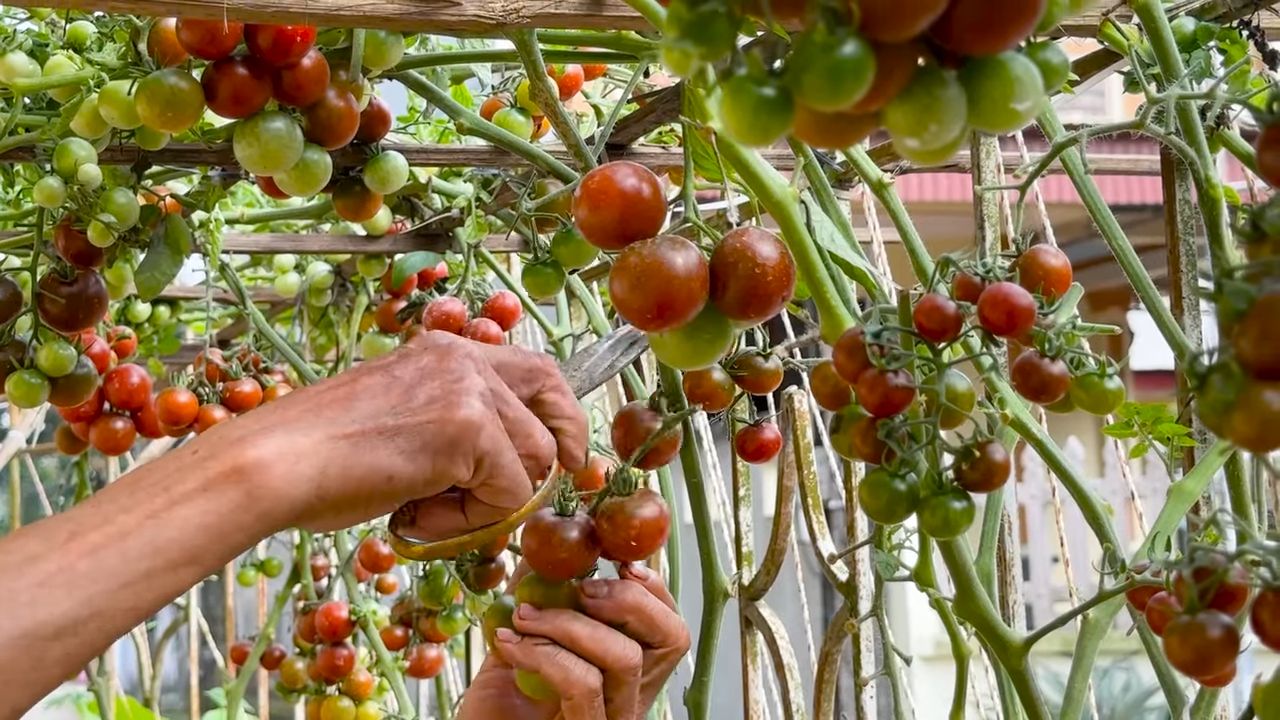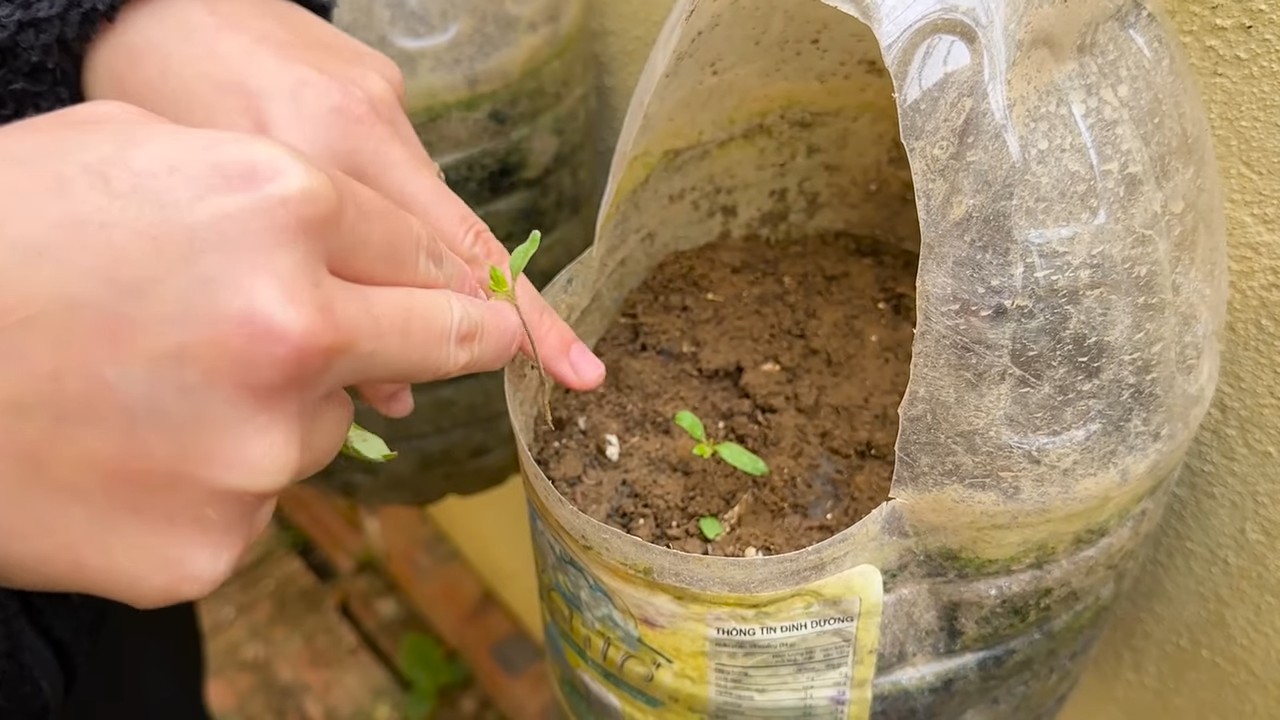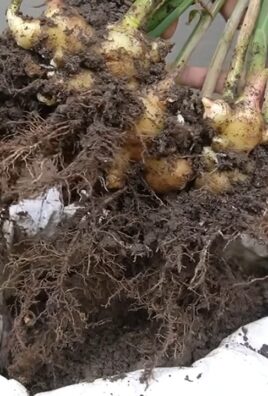Growing tomatoes at home can feel like a daunting task, but trust me, it’s one of the most rewarding experiences a gardener can have! Imagine biting into a sun-warmed, juicy tomato you nurtured from a tiny seed – the flavor is simply unmatched. But let’s be honest, sometimes those store-bought seedlings just don’t thrive, or maybe you’re facing a pest problem that seems impossible to solve. That’s where a little DIY magic comes in!
For centuries, cultures around the world have cultivated tomatoes, from their origins in South America to their adoption in Italian cuisine and beyond. These vibrant fruits have become a staple in our diets, and learning to grow them ourselves connects us to that rich history. But more than that, in today’s world, where we’re increasingly conscious of where our food comes from, growing tomatoes at home offers a sustainable and healthy alternative.
This article is packed with simple, yet effective, DIY tricks and hacks that will transform your tomato-growing game. Whether you’re battling blossom end rot, struggling with space constraints, or simply looking for ways to boost your yield, I’ve got you covered. Get ready to unlock the secrets to a bountiful tomato harvest, all with a little creativity and elbow grease!

Tomatenanbau im eigenen Garten: Dein umfassender DIY-Leitfaden
Hallo Gartenfreunde! Ich freue mich riesig, euch heute in die wunderbare Welt des Tomatenanbaus einzuführen. Es gibt kaum etwas Befriedigenderes, als eine saftige, sonnengereifte Tomate aus dem eigenen Garten zu ernten. Und glaubt mir, es ist einfacher, als ihr vielleicht denkt! Dieser Leitfaden ist vollgepackt mit Tipps und Tricks, die euch vom Samen bis zur Ernte begleiten. Los geht’s!
Grundlagen für den Tomatenanbau
Bevor wir uns ins Detail stürzen, hier ein paar wichtige Punkte, die ihr beachten solltet:
* Standort: Tomaten lieben die Sonne! Wählt einen Standort, der mindestens 6-8 Stunden direkte Sonneneinstrahlung pro Tag erhält.
* Boden: Der Boden sollte gut durchlässig, locker und reich an organischen Stoffen sein.
* Wasser: Regelmäßiges Gießen ist entscheidend, besonders während der Fruchtbildung. Vermeidet Staunässe!
* Unterstützung: Tomatenpflanzen brauchen Unterstützung, um nicht umzuknicken. Verwendet Rankgitter, Stäbe oder Spiralen.
* Sortenwahl: Es gibt unzählige Tomatensorten! Wählt Sorten, die zu eurem Klima und euren Vorlieben passen.
Aussaat und Anzucht
Ich beginne meine Tomatenanzucht meistens schon im Februar oder März, damit ich im Mai kräftige Jungpflanzen habe.
1. Samen vorbereiten: Ihr könnt Tomatensamen online, im Gartencenter oder sogar aus einer besonders leckeren Tomate gewinnen. Wenn ihr Samen aus einer Tomate nehmt, lasst sie ein paar Tage in etwas Wasser fermentieren, um die Keimung zu verbessern.
2. Aussaatgefäße vorbereiten: Ich verwende gerne Anzuchtschalen oder kleine Töpfe. Füllt sie mit Anzuchterde. Diese ist nährstoffarm und verhindert, dass die jungen Wurzeln verbrennen.
3. Aussaat: Legt 2-3 Samen pro Topf etwa 0,5-1 cm tief in die Erde. Bedeckt sie leicht mit Erde und befeuchtet die Oberfläche mit einer Sprühflasche.
4. Für Wärme sorgen: Tomaten keimen am besten bei Temperaturen zwischen 20 und 25 Grad Celsius. Stellt die Anzuchtschalen an einen warmen Ort, z.B. auf eine Fensterbank über der Heizung oder in ein Mini-Gewächshaus. Eine Heizmatte kann auch helfen.
5. Feuchtigkeit halten: Die Erde sollte immer leicht feucht sein, aber nicht nass. Besprüht sie regelmäßig mit Wasser.
6. Keimung abwarten: Nach etwa 7-14 Tagen sollten die ersten Keimlinge erscheinen.
7. Pikieren: Sobald die Keimlinge ihre ersten richtigen Blätter (nach den Keimblättern) entwickelt haben, ist es Zeit zum Pikieren. Das bedeutet, dass ihr die kleinen Pflänzchen vorsichtig in größere Töpfe umsetzt, damit sie mehr Platz zum Wachsen haben.
* Füllt die größeren Töpfe mit Tomatenerde.
* Löst die Keimlinge vorsichtig mit einem Pikierstab oder einem Löffel aus der Anzuchtschale. Achtet darauf, die Wurzeln nicht zu beschädigen.
* Setzt jeden Keimling einzeln in einen Topf und bedeckt die Wurzeln mit Erde. Drückt die Erde leicht an.
* Gießt die Jungpflanzen vorsichtig an.
8. Helles Licht: Nach dem Pikieren brauchen die Jungpflanzen viel Licht. Stellt sie an ein helles Fenster oder verwendet eine Pflanzenlampe.
9. Abhärten: Bevor ihr die Tomatenpflanzen ins Freie pflanzt, müsst ihr sie abhärten. Das bedeutet, dass ihr sie langsam an die Bedingungen im Freien gewöhnt. Stellt sie tagsüber für ein paar Stunden nach draußen und holt sie abends wieder rein. Steigert die Zeit im Freien jeden Tag, bis sie schließlich den ganzen Tag draußen bleiben können.
Auspflanzen ins Freie
Nach den Eisheiligen (Mitte Mai) ist es endlich soweit: Die Tomatenpflanzen dürfen ins Freie!
1. Standort vorbereiten: Wählt einen sonnigen Standort mit gut durchlässigem Boden. Lockert den Boden auf und entfernt Unkraut.
2. Boden verbessern: Mischt Kompost oder gut verrotteten Mist unter die Erde, um sie mit Nährstoffen anzureichern.
3. Pflanzlöcher ausheben: Grabt Pflanzlöcher, die etwas größer sind als die Töpfe der Tomatenpflanzen.
4. Pflanzen einsetzen: Nehmt die Tomatenpflanzen vorsichtig aus den Töpfen und setzt sie in die Pflanzlöcher. Achtet darauf, dass der Wurzelballen nicht beschädigt wird.
5. Tiefer pflanzen: Tomaten können tiefer gepflanzt werden als sie im Topf standen. Das fördert die Wurzelbildung und macht die Pflanzen stabiler. Entfernt die unteren Blätter, bevor ihr die Pflanzen tiefer setzt.
6. Erde auffüllen: Füllt die Pflanzlöcher mit Erde auf und drückt sie leicht an.
7. Angießen: Gießt die Tomatenpflanzen gründlich an.
8. Stütze anbringen: Bringt sofort eine Stütze (Rankgitter, Stab oder Spirale) an, damit die Pflanzen Halt haben.
9. Mulchen: Mulcht den Boden um die Tomatenpflanzen mit Stroh, Heu oder Rasenschnitt. Das hält den Boden feucht, unterdrückt Unkraut und schützt die Pflanzen vor Spritzwasser.
Pflege während der Wachstumsphase
Jetzt beginnt die eigentliche Arbeit: Die Tomatenpflanzen wollen gehegt und gepflegt werden!
1. Gießen: Gießt die Tomatenpflanzen regelmäßig, besonders während der Fruchtbildung. Gießt am besten morgens, damit die Blätter über den Tag abtrocknen können. Vermeidet Staunässe!
2. Düngen: Tomaten sind Starkzehrer und brauchen regelmäßig Dünger. Verwendet einen speziellen Tomatendünger oder einen organischen Dünger wie Brennnesseljauche. Düngt alle 2-3 Wochen.
3. Ausgeizen: Das Ausgeizen ist wichtig, um die Bildung von Seitentrieben zu verhindern. Diese nehmen der Pflanze unnötig Kraft und Energie. Brecht die Seitentriebe, die in den Blattachseln wachsen, regelmäßig aus. Am besten macht ihr das, wenn die Triebe noch klein sind.
4. Blätter entfernen: Entfernt die unteren Blätter, die den Boden berühren. Das verbessert die Belüftung und beugt Krankheiten vor.
5. Krankheiten und Schädlinge: Achtet auf Anzeichen von Krankheiten und Schädlingen. Bei Bedarf könnt ihr biologische Pflanzenschutzmittel einsetzen. Die Kraut- und Braunfäule ist eine häufige Tomatenkrankheit. Achtet auf braune Flecken auf den Blättern und Früchten. Entfernt befallene Blätter sofort und behandelt die Pflanzen mit einem Fungizid.
6. Bestäubung: In der Regel bestäuben sich Tomaten selbst. Ihr könnt die Bestäubung aber unterstützen, indem ihr die Pflanzen leicht schüttelt oder mit einem Pinsel die Blüten bestäubt.
Erntezeit!
Endlich ist es soweit: Die Tomaten sind reif und können geerntet werden!
1. Reife erkennen: Reife Tomaten haben eine intensive Farbe und geben auf leichten Druck nach.
2. Ernten: Pflückt die Tomaten vorsichtig ab, ohne die Pflanze zu beschädigen.
3. Lagerung: Lagert die Tomaten an einem kühlen, dunklen Ort. Nicht im Kühlschrank!
4. Genießen: Jetzt könnt ihr eure selbstgezogenen Tomaten genießen! Ob pur, im Salat, in der Soße oder als Suppe – sie schmecken einfach köstlich!
Zusätzliche Tipps und Tricks
* Tomaten im Topf anbauen: Auch auf dem Balkon oder der Terrasse könnt ihr Tomaten anbauen. Wählt dafür größere Töpfe (mindestens 20 Liter) und verwendet eine spezielle Tomatenerde.
* Verschiedene Sorten ausprobieren: Es gibt unzählige Tomatensorten! Probiert

Conclusion
So, there you have it! Growing tomatoes at home, especially with these simple DIY tricks, is not just a gardening endeavor; it’s an investment in flavor, freshness, and a deeper connection to your food. We’ve explored how to nurture those tiny seedlings into robust, fruit-bearing plants, all within the comfort of your own backyard or even a sunny balcony.
Why is this a must-try? Because store-bought tomatoes, while convenient, often lack the vibrant taste and juicy texture of homegrown varieties. They’re bred for shelf life and transport, sacrificing flavor in the process. With your own tomato plants, you control every aspect of their growth, from the soil they’re planted in to the amount of sunlight they receive. This translates to tomatoes bursting with unparalleled flavor, perfect for salads, sauces, sandwiches, or simply enjoying straight from the vine.
Beyond the superior taste, growing your own tomatoes is incredibly rewarding. There’s a unique satisfaction in watching a tiny seed transform into a thriving plant, laden with delicious fruit. It’s a therapeutic activity that connects you with nature and provides a sense of accomplishment. Plus, it’s a fantastic way to reduce your carbon footprint by minimizing the transportation and packaging associated with store-bought produce.
But the benefits don’t stop there! You also have complete control over the pesticides and fertilizers used (or not used!) on your plants. Opt for organic methods and enjoy tomatoes that are not only delicious but also healthy and environmentally friendly.
Ready to take your tomato growing to the next level? Consider these variations and suggestions:
* Experiment with different varieties: From the classic beefsteak to the sweet cherry tomato and the tangy Roma, there’s a tomato variety to suit every taste. Don’t be afraid to try something new and discover your favorites.
* Companion planting: Enhance your tomato plants’ growth and deter pests by planting basil, marigolds, or carrots nearby. These companion plants offer mutual benefits, creating a thriving ecosystem in your garden.
* Vertical gardening: If you’re short on space, consider growing tomatoes in hanging baskets or using trellises. Vertical gardening maximizes space and adds visual appeal to your garden.
* Seed saving: Save seeds from your best-performing tomato plants to grow them again next year. This is a great way to preserve heirloom varieties and adapt your plants to your local climate.
* DIY fertilizer: Create your own organic fertilizer using compost, eggshells, or coffee grounds. These natural fertilizers provide essential nutrients for healthy tomato growth.
We’re confident that with a little effort and these DIY tricks, you’ll be harvesting a bountiful crop of delicious tomatoes in no time. So, grab your gardening gloves, gather your supplies, and get ready to experience the joy of growing your own tomatoes at home.
Don’t just take our word for it – try it yourself! We encourage you to embark on this tomato-growing adventure and share your experiences with us. What varieties did you choose? What challenges did you face? What successes did you celebrate? Share your tips, tricks, and photos in the comments below. We can’t wait to hear about your homegrown tomato journey! Let’s build a community of passionate tomato growers and learn from each other. Happy gardening!
Frequently Asked Questions (FAQ)
Q: What is the best time to start growing tomatoes from seed?
A: The ideal time to start growing tomatoes from seed depends on your local climate and the length of your growing season. In general, you should start seeds indoors 6-8 weeks before the last expected frost. This allows the seedlings to develop a strong root system before being transplanted outdoors. Check your local weather forecasts and gardening resources to determine the specific timing for your region.
Q: What kind of soil is best for growing tomatoes?
A: Tomatoes thrive in well-draining soil that is rich in organic matter. A slightly acidic soil pH of 6.0 to 6.8 is ideal. Amend your soil with compost, aged manure, or other organic materials to improve its fertility and drainage. Avoid heavy clay soils, as they can become waterlogged and hinder root growth. If you have clay soil, consider growing tomatoes in raised beds or containers with a well-draining potting mix.
Q: How much sunlight do tomatoes need?
A: Tomatoes require at least 6-8 hours of direct sunlight per day to produce a bountiful harvest. Choose a sunny location in your garden that receives ample sunlight throughout the day. If you’re growing tomatoes in containers, make sure to place them in a spot that gets plenty of sun. Insufficient sunlight can lead to leggy plants, reduced fruit production, and bland-tasting tomatoes.
Q: How often should I water my tomato plants?
A: Water tomato plants deeply and regularly, especially during hot, dry weather. Aim to water at the base of the plant, avoiding wetting the foliage, which can increase the risk of fungal diseases. The frequency of watering will depend on the weather, soil type, and size of the plant. Check the soil moisture regularly by sticking your finger into the soil about an inch deep. If the soil feels dry, it’s time to water.
Q: What are some common tomato pests and diseases, and how can I prevent them?
A: Tomatoes are susceptible to various pests and diseases, including aphids, whiteflies, tomato hornworms, blossom end rot, and early blight. To prevent these problems, practice good garden hygiene, such as removing weeds and debris, and providing adequate spacing between plants for air circulation. Use organic pest control methods, such as insecticidal soap or neem oil, to control pests. Choose disease-resistant tomato varieties and avoid overhead watering to minimize the risk of fungal diseases.
Q: How do I know when my tomatoes are ripe?
A: The color of the tomato will change from green to its mature color, depending on the variety. The tomato should also feel slightly soft to the touch but not mushy. Gently twist the tomato from the vine; if it comes off easily, it’s ripe. The aroma of a ripe tomato is also a good indicator of ripeness.
Q: What is blossom end rot, and how can I prevent it?
A: Blossom end rot is a common tomato problem caused by a calcium deficiency. It appears as a dark, leathery spot on the bottom of the tomato. To prevent blossom end rot, ensure that your soil has adequate calcium levels and that your plants receive consistent watering. Amend your soil with lime or bone meal before planting to increase calcium availability. Avoid over-fertilizing with nitrogen, as this can interfere with calcium uptake.
Q: Can I grow tomatoes in containers?
A: Yes, tomatoes can be successfully grown in containers, especially determinate or bush varieties. Choose a large container (at least 10 gallons) with drainage holes and fill it with a high-quality potting mix. Provide adequate sunlight, water, and fertilizer. Consider using a tomato cage or stake to support the plant as it grows.
Q: How do I prune my tomato plants?
A: Pruning tomato plants can improve air circulation, reduce disease risk, and encourage fruit production. Remove suckers (the small shoots that grow between the main stem and branches) to direct the plant’s energy towards fruit development. Prune off any yellowing or diseased leaves. Determinate varieties require less pruning than indeterminate varieties.
Q: What are some good companion plants for tomatoes?
A: Several plants can benefit tomatoes when planted nearby. Basil repels tomato hornworms and whiteflies, while marigolds deter nematodes and other soil pests. Carrots improve soil drainage and attract beneficial insects. Other good companion plants for tomatoes include onions, garlic, parsley, and nasturtiums. Avoid planting tomatoes near brassicas (such as cabbage and broccoli) or fennel, as they can inhibit tomato growth.





Leave a Comment